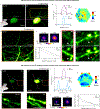An adaptive optics module for deep tissue multiphoton imaging in vivo
- PMID: 34608309
- PMCID: PMC9090585
- DOI: 10.1038/s41592-021-01279-0
An adaptive optics module for deep tissue multiphoton imaging in vivo
Abstract
Understanding complex biological systems requires visualizing structures and processes deep within living organisms. We developed a compact adaptive optics module and incorporated it into two- and three-photon fluorescence microscopes, to measure and correct tissue-induced aberrations. We resolved synaptic structures in deep cortical and subcortical areas of the mouse brain, and demonstrated high-resolution imaging of neuronal structures and somatosensory-evoked calcium responses in the mouse spinal cord at great depths in vivo.
© 2021. The Author(s), under exclusive licence to Springer Nature America, Inc.
Conflict of interest statement
Competing interests
N.J. and Howard Hughes Medical Institute have filed patent applications that relate to the principle of frequency-multiplexed aberration measurement. T.G.B. has a financial interest in Boston Micromachines Corporation (BMC), which produced commercially the deformable mirror used in this work. The remaining authors declare no competing interests.
Figures












References
-
- Wang T & Xu C Three-photon neuronal imaging in deep mouse brain. Optica 7, 947–960 (2020).
-
- Kubby Joel A. Adaptive Optics for Biological Imaging. (CRC Press, 2013).
-
- Booth MJ Adaptive optical microscopy: The ongoing quest for a perfect image. Light Sci. Appl 3, 1–7 (2014).
Publication types
MeSH terms
Substances
Grants and funding
LinkOut - more resources
Full Text Sources
Molecular Biology Databases

